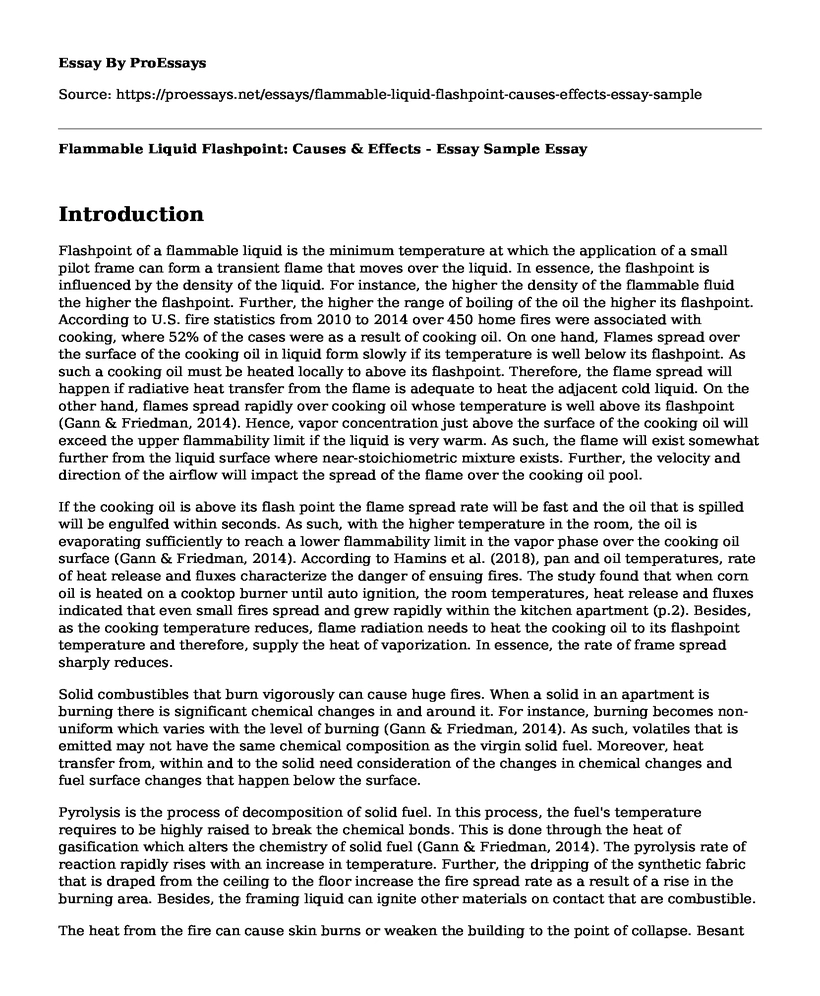Introduction
Flashpoint of a flammable liquid is the minimum temperature at which the application of a small pilot frame can form a transient flame that moves over the liquid. In essence, the flashpoint is influenced by the density of the liquid. For instance, the higher the density of the flammable fluid the higher the flashpoint. Further, the higher the range of boiling of the oil the higher its flashpoint. According to U.S. fire statistics from 2010 to 2014 over 450 home fires were associated with cooking, where 52% of the cases were as a result of cooking oil. On one hand, Flames spread over the surface of the cooking oil in liquid form slowly if its temperature is well below its flashpoint. As such a cooking oil must be heated locally to above its flashpoint. Therefore, the flame spread will happen if radiative heat transfer from the flame is adequate to heat the adjacent cold liquid. On the other hand, flames spread rapidly over cooking oil whose temperature is well above its flashpoint (Gann & Friedman, 2014). Hence, vapor concentration just above the surface of the cooking oil will exceed the upper flammability limit if the liquid is very warm. As such, the flame will exist somewhat further from the liquid surface where near-stoichiometric mixture exists. Further, the velocity and direction of the airflow will impact the spread of the flame over the cooking oil pool.
If the cooking oil is above its flash point the flame spread rate will be fast and the oil that is spilled will be engulfed within seconds. As such, with the higher temperature in the room, the oil is evaporating sufficiently to reach a lower flammability limit in the vapor phase over the cooking oil surface (Gann & Friedman, 2014). According to Hamins et al. (2018), pan and oil temperatures, rate of heat release and fluxes characterize the danger of ensuing fires. The study found that when corn oil is heated on a cooktop burner until auto ignition, the room temperatures, heat release and fluxes indicated that even small fires spread and grew rapidly within the kitchen apartment (p.2). Besides, as the cooking temperature reduces, flame radiation needs to heat the cooking oil to its flashpoint temperature and therefore, supply the heat of vaporization. In essence, the rate of frame spread sharply reduces.
Solid combustibles that burn vigorously can cause huge fires. When a solid in an apartment is burning there is significant chemical changes in and around it. For instance, burning becomes non-uniform which varies with the level of burning (Gann & Friedman, 2014). As such, volatiles that is emitted may not have the same chemical composition as the virgin solid fuel. Moreover, heat transfer from, within and to the solid need consideration of the changes in chemical changes and fuel surface changes that happen below the surface.
Pyrolysis is the process of decomposition of solid fuel. In this process, the fuel's temperature requires to be highly raised to break the chemical bonds. This is done through the heat of gasification which alters the chemistry of solid fuel (Gann & Friedman, 2014). The pyrolysis rate of reaction rapidly rises with an increase in temperature. Further, the dripping of the synthetic fabric that is draped from the ceiling to the floor increase the fire spread rate as a result of a rise in the burning area. Besides, the framing liquid can ignite other materials on contact that are combustible.
The heat from the fire can cause skin burns or weaken the building to the point of collapse. Besant burns are very common and in most cases lethal. The author posits that children are more likely to get thermal burns because they are active. Similarly, fire can destroy a building by making it weaken. Besant also established that 80% of deaths 240 house fire deaths are as a result of smoke inhalation. Gann (2004) posits that smoke incapacitates people once inhaled due to its smoke potency. As such, there is an urgent need to establish a basis for people's safety.
Conclusion
In conclusion, to optimize fire safety, it is imperative to comprehend the cooking oil and solid fuel fire development from ignition to fire spread and growth.
References
Gann, R. G. (2004). Estimating data for incapacitation of people by fire smoke. Fire Technology, 40(2), 201-207.
Gann, R., & Friedman, R. (2014). Principles of fire behavior and combustion. Jones & Bartlett Publishers.
Hamins, A., Kim, S. C., & Madrzykowski, D. (2018). Characterization of stovetop cooking oil fires. Journal of Fire Sciences, 36(3), 224-239.ences
Patrick E. Besant-Matthews, M.D. (2019, September 16). Burns, fire and arson deaths and injuries. Retrieved from https://www.crime-scene-investigator.net/burns-fire-and-arson-deaths-and-injuries.html
Cite this page
Flammable Liquid Flashpoint: Causes & Effects - Essay Sample. (2023, Mar 26). Retrieved from https://proessays.net/essays/flammable-liquid-flashpoint-causes-effects-essay-sample
If you are the original author of this essay and no longer wish to have it published on the ProEssays website, please click below to request its removal:
- The Future of Puerto Rico
- Research Paper Example: Skydiving and Science Advancement
- Types of Pendulum Research Paper Example
- The Properties of Life, Basic Chemical Terminology, and Molecules and Compounds of a Cell Necessary for Life
- Discovering the Universe: Bing Bang Theory, String Theory Paper Example
- Essay Sample on Learning of Mathematics
- Personal Statement on Mathematics Major







